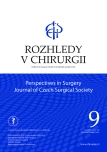-
Medical journals
- Career
Laparoscopic versus open hernia repair in patients with incarcerated inguinal hernia
Authors: M. Kepičová; P. Ihnát
Authors‘ workplace: Katedra chirurgických oborů Lékařské fakulty Ostravské univerzity, Ostrava ; Chirurgická klinika, Fakultní nemocnice Ostrava
Published in: Rozhl. Chir., 2021, roč. 100, č. 9, s. 440-444.
Category: Original articles
doi: https://doi.org/10.33699/PIS.2021.100.9.440–444Overview
Introduction: Laparoscopic approach is employed very rarely in the treatment of patients with incarcerated inguinal hernia. The aim of the present study was to evaluate the safety and benefits of laparoscopic hernioplasty (TAPP) in the treatment of incarcerated inguinal hernia.
Methods: It was a retrospective clinical study focused on comparison of perioperative and postoperative outcomes of laparoscopic and open hernia repair of incarcerated inguinal hernia. All adult patients undergoing surgery for incarcerated inguinal hernia at the University Hospital Ostrava between 2014 and 2018 were included in the study.
Results: In total, 31 patients were enrolled into the study (20 patients with open hernia repair and 11 patients with laparoscopic transabdominal preperitoneal hernioplasty [TAPP]). Operative time was shorter in the laparoscopic group (69.5 vs 82.2 min, p=0.444); length of hospital stay was significantly shorter in the TAPP group (3.45 vs 8.5 days, p=0.010). Postoperative complications were more frequent in the open hernia repair group (40% vs 0.0%, p=0.134); the difference was not statistically significant.
Conclusion: Laparoscopic hernioplasty provides a safe and effective operating technique for patients with incarcerated inguinal hernia.
Keywords:
incarcerated inguinal hernia – hernioplasty – laparoscopy – TAPP – technique of reposition
Sources
1. Czudek S. Diagnostika a léčba kýl dutiny břišní. In: Duda M. a kolektiv. Základní výkony ve všeobecné chirurgii. 1. vyd. (online) Olomouc, Univerzita Palackého v Olomouci 2012 : 10.
2. Hrivnák R, Hanke I, Penka I, et al. Amyandova hernie − vzácná náhlá příhoda břišní. Rozhl Chir. 2011 Sep;90(9):523−526. PMID:22320118.
3. Simons MP, Saufenacker T, Bay-Nielsen M, et al. European Hernia Society guidelines on the treatment of inguinal hernia in adult patients. Hernia 2009;13(4):343−403. doi:10.1007/ s10029-009-0529-7.
4. Chmátal P, Tuka L, Jandová D. Analýza 6879 operací tříselné kýly v České republice z pohledu databáze Vojenské zdravotní pojišťovny České republiky. Rozhl Chir. 2016 Spring;95(5):188−191. PMID:2733674.
5. Sun L, Shen YM, Chen J. Laparoscopic versus Lichtenstein hernio plasty for inguinal hernias: a systematic review and meta-analysis of randomized controlled trials. Minim Invasive Ther Allied Technol. 2020 Feb;29(1):20−27. doi:10.1080/1364 5706.2019.1569534.
6. Patterson TJ, Beck J, Currie PJ, et al. Meta - analysis of patient-reported outcomes after laparoscopic versus open inguinal hernia repair. Br J Surg. 2019 Jun;106(7):824−836. doi:10.1002/ bjs.11139.
7. Li J, Wang X, Feng X, et al. Comparison of open and laparoscopic preperitoneal repair of groin hernia. Surg Endosc. 2013 Dec;27(12):4702−4710. doi:10.1007/ s00464-013-3118-x.
8. Perez AJ, Strassle PD, Sadava EE, et al. Nation wide analysis of inpatient laparoscopic versus open inguinal hernia repair. J Laparoendosc Adv Surg Tech A. 2020 Mar;30(3):292−298. doi:10.1089/ lap.2019.0656.
9. Yang S, Zhang G, Jin C, et al. Transabdominal preperitoneal laparoscopic approach for incarcerated inguinal hernia repair: A report of 73 cases. Medicine (Baltimore) 2016 Dec;95(52):e5686. doi: 10.1097/MD.0000000000005686.
10. Chihara N, Suzuki H, Sukegawa M, et al. Is the laparoscopic approach feasible for reduction and herniorrhaphy in cases of acutely incarcerated/strangulated groin and obturator hernia?: 17-Year experience from open to laparoscopic approach. J Laparoendosc Adv Surg Tech A. 2019 May;29(5):631−637. doi:10.1089/ lap.2018.0506.
11. Payiziwula J, Zhao PJ, Aierken A, et al. Laparoscopy versus open incarcerated inguinal hernia repair in octogenarians: Single-center experience with Word review. Surg Laparosc Endosc Percutan Tech. 2019 Apr;29(2):138−140. doi:10.1097/SLE.0000000000000629.
12. Sawayama H, Kanemitsu K, Okuma T, et al. Safety of polypropylene mesh for incarcerated groin and obturator hernias: a retrospective study of 110 patients. Hernia 2014 Jun;18(3):399−406. doi:10.1007/ s10029-013-1058-y.
13. Liu J, Zhai Z, Chen J. The use of prosthetic mesh in the emergency management of acute incarcerated inguinal hernias. Surg Innov. 2019 Jun;26(3):344−349. doi:10.1177/1553350619828900.
14. Yang B, Zhou S, Li Y, et al. A comparison of outcomes between Lichtenstein and laparoscopic transabdominal preperitoneal hernioplasty for recurrent inguinal hernia. Am Surg. 2018 Nov;84(11):1774−1780. doi:10.9738/cc53.1.
15. Koju R, Koju RB, Malla B, et al. Transabdominal pre-peritoneal mesh repair versus Lichtenstein‘s hernioplasty. J Nepal Health Res Counc. 2017 Sep;15(2):135−140. doi:10.3126/jnhrc. v15i2.18202. PMID: 29016583.
16. Pisanu A, Podda M, Saba A, et al. Meta-analysis and review of prospective randomized trials comparing laparoscopic and Lichtenstein techniques in recurrent inguinal hernia repair. Hernia 2015 Jun;19(3):355−366. doi:10.1007/s10029-014-1281-1.
Labels
Surgery Orthopaedics Trauma surgery
Article was published inPerspectives in Surgery

2021 Issue 9-
All articles in this issue
- Atestace
- Komentář k editorialu pana profesora Pavla Pafka
- Prehabilitation, improving postoperative outcomes
- Acute appendicitis during the spring COVID-19 pandemic in 2020 – a comparative retrospective study
- Regenerative abilities of a nanofiber wound dressing based on polylactide
- Laparoscopic versus open hernia repair in patients with incarcerated inguinal hernia
- Synchronous tumor duplicity of a neuroendocrine tumor of Meckel’s diverticulum with liver metastases and colorectal carcinoma
- Omental torsion as a possible cause of acute abdomen
- Thrombolysis as a treatment for transplant renal artery thrombosis – a report of three unsuccessful cases and an overview of reported cases
- Perspectives in Surgery
- Journal archive
- Current issue
- Online only
- About the journal
Most read in this issue- Prehabilitation, improving postoperative outcomes
- Laparoscopic versus open hernia repair in patients with incarcerated inguinal hernia
- Omental torsion as a possible cause of acute abdomen
- Atestace
Login#ADS_BOTTOM_SCRIPTS#Forgotten passwordEnter the email address that you registered with. We will send you instructions on how to set a new password.
- Career

